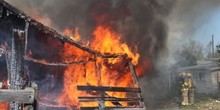Several barn fires throughout the USA during the month of December serve as a warning to horse owners to be ever vigilant about barn safety and fire prevention, not only in December but throughout the year. Newspaper articles and television news give credence to the fact that barn and stable fires are often fatal to both horses and humans.

Horse fatalities in barn fire
Newspaper articles and television news give credence to the fact that barn and stable fires are often fatal to both horses and humans.
An early-morning barn fire struck an equine training center in Lexington, Kentucky on December 18, 2016, killing dozens of horses, most of them yearlings, according to a police report.
A worker at the facility, Emory Brenklin said he saw the flames and could only think of one thing to do: âJust try to stay alive myself and get as many horses out as I could."
Workers rescued as many horses as they could before flames overtook the structure. In all, 13 animals of the 36 horses inside the barn at the time made it out alive.
According to a worker the horses tried to run back in the barn making the resuce more difficult. Finally, the barn started collapsing and rescue efforts had to be called it off.
Fire officials did not immediately confirm what started the fire, but it was thought the barn may have been struck by lightning during a Saturday night storm.
In Brighton, Colorado at least 16 horses were killed in an early-morning barn fire on December 13th.
Crews initially were called out just after 1 a.m. Upon arrival, a barn about 60 feet by 80 feet was found to be fully involved in flames.
Firefighters did all they could to save the animals, but the intensity of the flames kept them from getting inside to rescue the horses.
What you can do to prevent barn and stable fires:
In many communities, fire departments have fire prevention programs and will be willing to visit your barn, so they know you and where you are. In addition to visiting your barn, they are often able to offer important advice about everything from brush clearing to fire-preventing electrical solutions.
- Smoking should be banned within a minimum of 50 feet of barns and stables.
- Fire extinguishers that are properly up-dated and charged on a regular basis should be kept near every exterior door and next to the main electrical panel box.
- Hay and all combustibles should be properly stored, and, if possible, kept in a separate structure.
- All lighting and electrical wiring should be checked several times a year and repaired whenever necessary.
- Barn and stable layout should be safety-oriented with exits clearly marked for use in case of emergency. Door frames should be a minimum of 8 feet high and 4 feet wide for easy ingress and egress. More than one exit should be provided in all cases and all personnel should be trained in what to do in case of fire.
- Develop an evacuation plan and post it prominently. Include fire department, veterinarian, and emergency service phone numbers and also include how you can be reached if not on the premises.
- A 50-foot firebreak should be cleared around your barn by removing grass, brush, trees and debris.
- Smoke and carbon monoxide detectors that sound a loud external alarm should be installed in every barn and stable area.
- Have a water and power supply installed outside your barn near the barn doors and keep a water hose attached to the outdoor water supply. Consider installing a sprinkler system. The initial cost may be high, but you may receive up to a 50% discount on your fire insurance each year.
